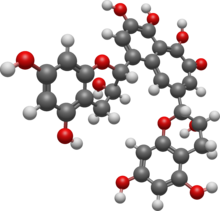
| |

| |
| Names | |
|---|---|
| Systematic IUPAC name
3,4,5-Trihydroxy-1,8-bis[(2R,3R)-3,5,7-trihydroxy-3,4-dihydro-2H-1-benzopyran-2-yl]-6H-benzo[7]annulen-6-one | |
| Identifiers | |
3D model (JSmol)
|
|
| ChEMBL | |
| ChemSpider | |
PubChem CID
|
|
| UNII | |
CompTox Dashboard (EPA)
|
|
| |
| |
| Properties | |
| C29H24O12 | |
| Molar mass | 564.499 g·mol−1 |
Except where otherwise noted, data are given for materials in their standard state (at 25 °C [77 °F], 100 kPa).
| |
Theaflavin (TF) and its derivatives, known collectively as theaflavins, are antioxidant polyphenols that are formed from the condensation of flavan-3-ols in tea leaves during the enzymatic oxidation (sometimes erroneously referred to as fermentation) of black tea. Theaflavin-3-gallate, theaflavin-3'-gallate, and theaflavin-3-3'-digallate are the main theaflavins.[1] Theaflavins are types of thearubigins, and are therefore reddish in color.
See also[edit]
References[edit]
- ^ "Theaflavin Effectiveness, Safety, and Drug Interactions on RxList". rxlist.com. Archived from the original on 4 September 2017. Retrieved 24 April 2018.
Well, that’s interesting to know that Psilotum nudum are known as whisk ferns. Psilotum nudum is the commoner species of the two. While the P. flaccidum is a rare species and is found in the tropical islands. Both the species are usually epiphytic in habit and grow upon tree ferns. These species may also be terrestrial and grow in humus or in the crevices of the rocks.
View the detailed Guide of Psilotum nudum: Detailed Study Of Psilotum Nudum (Whisk Fern), Classification, Anatomy, Reproduction